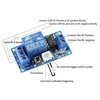Hi Folks,
Newbie electronics geek here. I've been slowly dabbling with micro-electronics and decided I wanted to attempt to build a single switch/multi-location on-off controller for the air compressor in my garage. Perhaps a bit overkill, but that's me!
In order to make this work the way I want, I purchased a "1 channel latching relay module w/ Touch Bi-Stable Switch MCU control" from Amazon. After wiring up my circuit, everything works great except the switching device seems to sometimes not trip or over trip the electronic control. I'm basically using this small unit to trigger a high-current contactor to run the air compressor.
What's happening is this: I have a single contact momentary switch. When I depress the switch, it trips the flip-flop action of a 555 timer and energizes the larger contactor. Sometimes when I depress the switch, the contactor will bounce on/off/on/off a few times and stay in whatever state it was previously in before I pushed the switch. Its as if I pushed the switch a few times rather than once.
With my limited knowledge of electronics and how this works, I'm wondering if I'm getting come kind of ghost current that's triggering or setting off the timer circuit and making it flip-flop and flop-flip again very fast, several times. Is there anything I can/should put in series with the switch (i.e. a cap or resistor) to maybe smooth out the action of the switch ? This is the only thing I can think of.
Any help is much appreciated and thanks in advance!
Newbie electronics geek here. I've been slowly dabbling with micro-electronics and decided I wanted to attempt to build a single switch/multi-location on-off controller for the air compressor in my garage. Perhaps a bit overkill, but that's me!
In order to make this work the way I want, I purchased a "1 channel latching relay module w/ Touch Bi-Stable Switch MCU control" from Amazon. After wiring up my circuit, everything works great except the switching device seems to sometimes not trip or over trip the electronic control. I'm basically using this small unit to trigger a high-current contactor to run the air compressor.
What's happening is this: I have a single contact momentary switch. When I depress the switch, it trips the flip-flop action of a 555 timer and energizes the larger contactor. Sometimes when I depress the switch, the contactor will bounce on/off/on/off a few times and stay in whatever state it was previously in before I pushed the switch. Its as if I pushed the switch a few times rather than once.
With my limited knowledge of electronics and how this works, I'm wondering if I'm getting come kind of ghost current that's triggering or setting off the timer circuit and making it flip-flop and flop-flip again very fast, several times. Is there anything I can/should put in series with the switch (i.e. a cap or resistor) to maybe smooth out the action of the switch ? This is the only thing I can think of.
Any help is much appreciated and thanks in advance!
Attachments
Last edited:

